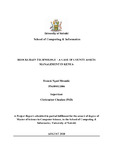Blockchain technology – a case of county assets management in Kenya

View/
Date
2018Author
Chepken, Christopher
Type
ThesisLanguage
enMetadata
Show full item recordAbstract
Integrity of database content is not absolute and cannot be guaranteed under the traditional
database management technologies leaving it vulnerable to violation of data integrity
requirements. This is so especially where the log files are easily accessible to a single entity
who may be a malicious database administrator or an authorized third party. Currently, there
is deficiency in fool-proof models and architectures that may guarantee accountability,
integrity and traceability of user actions in database systems. Various surveys have been
conducted in the past exposing quite a number of data integrity breaches in a public sector on
management of public assets. In line with these findings, the objective of the study was to
model an immutable peer to peer publicly accessible and distributed resource ledger to mimic
consensus management of assets based on the innovative blockchain technology. Surveys were
conducted to give further insight into the current asset management systems, and the results
integrated into the development of a private-public key cryptosystem - the underlying
technology for blockchain as a basis for resource management. An experiment was setup
targeting County Government asset management in Kenya in view of assessing applicability
of the blockchain technology through validation and verification procedures of various
transactions. The generated results indicated that the framework met the three requirements of
verifiability, validity and consensus in resource management; and is therefore applicable in
resource management applications where data integrity is key such as managing County
Government assets.
Publisher
University of Nairobi
